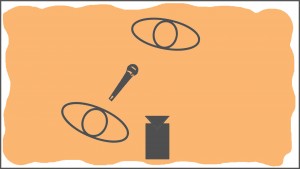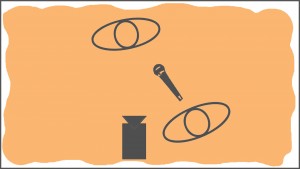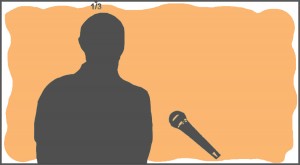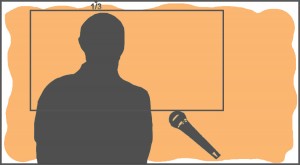Introduction
News items and reports are video formats used in TV. They vary between TV stations and are still evolving. The style depends on the owner of the station (national or private), the editorial policy, budget, and many other factors.
| |
Vision in action |
|
|
||
Equipment and tools
To record an interview you’ll need a camera with an external microphone input/separate sound recording device, and a tripod. You’ll also need headphones to check the sound on location.
Additional lights can help to improve your picture. You’ll also need a computer with internet access for research, writing and editing.
Main section
What is the difference between a news item and a report?
A TV news item lasts between 30 seconds and three minutes. A report can be up to an hour long, and explores the topic in more detail and from several different angles. It can include longer statements from a number of people people, more video footage and complex graphics.
News bulletins consist of several news items and last between 15 minutes and an hour.
TV news can react quickly to a developing situation quickly. A [feature] takes more time to investigate and prepare, shoot and edit.
The difference between a TV report and documentary films is in the method of obtaining and presenting information. The information for reports is obtained and presented objectively while producers of documentary films may promote their point of view and use creative ways of getting a message across, for example through animation.
Producing TV news
Daily TV news is produced frequently – old news is no news. That’s why it’s important to be up to date on developing stories, or even ‚break‘ the story first. This is especially that case for people working for a TV station or news website.
A journalist would usually get the task or permission to cover a story from an editor at the beginning of the day. Editors are invited to many events and press conferences. They also monitor developing events and areas they have a particular interest in, and develop ideas for news items that may be interesting for viewers. Editors are often open to proposals from their journalists and sometimes ask them to research stories themselves.
Once a journalist has a story to cover, a crew needs to form – usually made up of the journalist, a camera operator, and sometimes a sound and/or lights technician too. The journalist does the research, contacts the relevant people and develops a concrete idea of what has to be filmed.
The crew then goes out to gather the necessary material. This normally happens early in the day to give the journalist enough time to write the voice-over lines and select the interview answers he or she wants to include.
The voice-over will then be recorded in a studio, usually by the journalist or a news presenter. When everything is ready, the editor edits everything together.
This is quite a lot of effort for one day, and there can’t be any delays in delivering the news! With time every member of the team learns to work efficiently and to find solutions to problems quickly. Preparing news items is a huge team effort; a lot of people depend on each other and everyone has a specific responsibility. Sometimes trying to do everything on time can be stressful.
As a newcomer to the world of video you will most probably produce TV news that will not be so urgent to show to a wider public and you will not compete with others who will do it first.
You might produce a TV news item to show what you have been up to, the activities of your school or an organization you are involved in, or another topic that interests you. You can produce ‘fake’ TV news items about a topic you want to focus on, or do one as a parody.
This will give you the chance to learn and practise. Or you could focus on a report, which allows more time for research, shooting and editing.
How to choose a topic
One of the most important questions is: what do you want to cover in a TV news item or report?
Here are some tips on finding a topic:
- A novelty, an innovation, a new feature in an already established topic or event, for example a new book, person, building, app, accident.
- The event has an impact/influence on a lot of people.
- The event helps a lot of people – for example a new medicine.
- The event is important.
- The event is interesting.
- You can offer new insights into an already well-known topic.
- It’s possible to make a story out of it.
Daily TV news bulletins usually include topics such as political developments (for example new laws), the economy (unemployment, taxes, new investments), social and environmental topics (floods, earthquakes, environmental protection), sport, technological innovation, cultural, youth and leisure activities.
Many TV stations and news websites cover news from just one area – for example sport, the environment, sustainable life, art.
Feel free to choose what you want to present to a wider audience. You could even establish a news site on your own or with the help of friends and colleagues.
Elements of TV news items and reports
TV news items and reports usually consist of several elements combined together for interest and authenticity. You can use all or some of the following:
- Announcement: usually made in the studio by the news presenter but written by the journalist. The announcement explains what the news item is about in one or two short sentences.
- Report: the reporter stands in front of the camera and describes the situation into a microphone; this element comes either at the beginning or the end of the item. It’s often used in reports about unusual or catastrophic situations (floods, earthquakes) and political events to stress the impact of the situation, show its authenticity and convey the feelings of the reporter and others involved. The reporter stands in front of the scene so the audience can see what is going on in the background. Alternatively the reporter stands in front of a well-known building in the area where the event has happened, to prove they are abroad/at the scene.
- Image material: shots of the scene or other pictures relating to the topic. This gives the audience important visual information and confirms the description in the journalist’s voice-over (see below). The camera operator has to be quick, flexible and familiar with the basic concepts of editing, and shoot the material so it can be edited. Ideally the scene should be easy to understand even without a voice-over. To get the result you want, there needs to be good communication between journalist and camera operator.
A good TV-news camera operator will get to the heart of the action quickly, shoot what they need to, and quickly get out again. Less experienced camera operators try to film everything, which means huge amounts of material to edit. It takes a bit of practice, but you could be a great TV-news operator too!
- Voice-over: the voice of a journalist not present in the actual scene, explaining the situation while the audience watches visual material. A voice-over is recorded in a studio and includes information that makes the full story clearer for the viewer. A voice-over can also include details that you’re not able to show visually or aren’t covered in the interviewees‘ answers.
- Statements: opinions on the situation from 1–4 people who are involved. Statements can be for or against a particular development, or just descriptive. Try to talk to people that have different views. Where there is more than one statement, the journalist varies the position of the people in front of the camera (left or right), so that the images are more varied.
Left and right position of the microphone, Interviewer and interviewee.
The microphone should be completely outside the frame or inside it, and the interviewee should look at the interviewer rather than the camera, to give the viewer a 3/4 angle. Remember: everybody has the right to two eyes when being interviewed, so show both!
6. TV poll (survey): a direct way of getting short answers from passers-by. The journalist usually approaches people and asks one or two short questions; even if they don’t answer, a facial expression can also be included on its own to show a person’s reactions. To be on the safe side legally, while you’re still filming ask the people if they are happy for the material to be published. If the answer is no, you can’t use it. If they agree, you can publish the material, and you have proof of consent in case of a later appeal. When you film underage people you have to get the permission from their parent or guardian.
7. Graphics (charts, tables, graphs) and archive material (old photos and videos): Often it’s much easier for the audience to see the data than to just hear about it. A graph allows you to show things like the change in value of money and raw materials over time.
Archive material is very important for stories about the past. It can also help to compare a previous situation with the present one.
Example of a possible structure of TV news
| TIME FRAME/DURATION | WHAT DO WE HEAR? | WHAT DO WE SEE? |
| start 10 sec |
announcement | TV studio |
| 10 sec | report | journalist at the scene |
| 5–10 sec | sound from the scene | image material from the scene |
| 15–20 sec | statement 1 | person 1 |
| 15–20 sec | statement 2 | person 2 |
| 30 sec | voice-over 1 | graphic and archive material |
| 5–10 sec | sound from the scene | image material from the scene |
| 20 sec | voice-over 2 | image material from the scene |
| 15 –30 sec. | poll (survey) | passers-by giving opinions |
| end 15 sec |
voice-over 3 | image material from the scene |
How to do research?
As a journalist you are responsible for researching the topic you will be reporting on. If the topic is new to you, you’ll have to spend some time familiarising yourself with the current situation and how it has developed over time.
You can do research on the internet, but be careful to only use reliable sources or you risk using incorrect information. You can also contact the people involved or read other articles on the topic.
And don’t underestimate fellow journalists that have been in the business for years. They are a treasure trove of information; ask them to share it with you. In time you will gain knowledge and insights, and build a relationship with many new sources and contacts.
What questions should you ask in a TV news item or report?
These six fundamental questions are a good start – try to cover them in any news item or report: what happened, who was involved, where did it happen, when, how and why (see Producing an interview for more).
Using a blue or green screen
The green (or blue) screen is a technique used widely in TV news, weather forecasts, and so on. It is also used in movies to replace the background behind the subject.
Green is a more useful colour than blue in digital film-making. This is because digital cameras detects more detail in the green colour; green also requires less light than blue. Many people have blue eyes, which is another problem when blue is removed from the scene so that a new backdrop can replace the blue screen. For the same reason, actors in front of a green (or blue) screen should avoid wearing clothes in colours similar to the green (or blue) background.
Lighting is very important when using the green screen; be careful that there isn’t much or any shadow in the scene.
Whether you’re using a blue or green screen, you will need an editing program with a chroma keying effect, like Adobe Premiere or Final Cut. This will help you add a different background to a scene shot in front of a green (or blue) screen.
You can build a simple green or blue screen yourself using neon-green fabric or bright green or blue poster boards that you stitch or tape together and stick to a wall.
Video: Example of TV news by a school project in Germany, using a blue screen for presenting. (By WettinTV)
Common mistakes
- Trying to include too much information in a TV news item or report. The additional details are often not necessary or directly connected to the topic.
- The journalist isn’t objective enough. Their personal opinion becomes obvious in the TV news item/report.
- Not enough image material. Remember that images express more than words.
- The language is too complicated or scientific.
Exercises
- Watch TV news/report on different TV channels, and try to recognise different elements or styles.
- Film a TV news item/report about a topic or event in your area. Try to use several elements: image material, voice-over, interviews, etc.
Related topics and links to external resources
Chapter: Camera basics / Producing an interview
Methodology
Try to find a topic that you are familiar with and interested in. Don’t forget that some people won’t be willing to speak in front of the camera, and that some topics or stories can be sensitive. These can include historical events or social topics like homosexuality and poverty.
When working with a group of young people, first try to do something simple that will help them master the process, get fast results and gain experience. After that develop or expand the story, or look for a new one.
We also recommend that you accompany the young people on location but keep your distance and let them work alone.
Terminology
news, report, off voice, statements, TV poll (survey)






